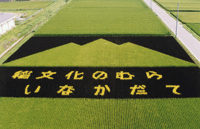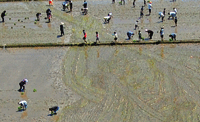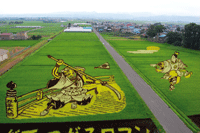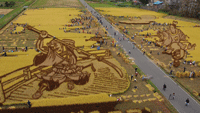
Rice and IP – A Recipe for Revitalization
Tanbo art – living artwork made from different varieties of rice to create giant images in rice paddies – is a unique effort to revitalize rural communities in Japan. The WIPO Japan Office caught up with the creators of this exciting and increasingly popular new form of artistic expression and with leaders of a small community which is taking it one step further by using the intellectual property (IP) system.
Breathing new life into rural communities
In front of the swaying rice paddies across from the Inakadate village hall on a summer’s day, it is hard to see what all the fuss is about. But from the vantage point of the mock castle that sits atop the village hall of this small farming community 600 kilometers north of Tokyo in the Aomori prefecture, all is revealed. What at ground level appears to be an ordinary rice field becomes, 20 meters higher up, a living work of art depicting famous Japanese warriors, intricately crafted from tens of thousands of rice plants.

Mount Iwaki, the design created by
Inakadate residents. (Photo: Inakadate
Village Hall)
A creative solution to a widespread problem
Tanbo art, which first appeared in Inakadate in 1993, is sweeping the country, from the island of Hokkaido in the north to the southern island of Kyushyu. The phenomenon is also gaining popularity in the Republic of Korea. In the early 90s, with an aging population of just over 8,000 inhabitants, many young people having moved to the city, Inakadate’s local government sought ways to revitalize its local economy, create jobs and attract people back to the community. One cold winter’s day village leaders called a meeting of local residents to try to find a solution.
Since Inakadate had no real tourist attractions, someone suggested they draw on the village’s centuries-old tradition of rice cultivation using different colored plants to create giant rice paddy art – tanbo art – to bring visitors to the village.
The local government-sponsored Village Revitalization Committee (VRC) identified a suitable 2,500 m2 field adjacent to the village hall – ideal because the village hall’s mock castle provided a perfect viewing point. The VRC then faced the more difficult task of choosing and creating a design.
Choosing a design
To keep things simple, the community decided to create an image of Mount Iwaki, a famous mountain visible from Inakadate, along with the words “Inakadate, a village of rice culture”. Hand drawn by a local art teacher, the design was plotted onto a diagram and mapped onto a field which was then planted with three unique varieties of rice, each with different colored leaves.
Inakadate’s local government organized a program of events around the tanbo art program, which encouraged community involvement and attracted tourists to the village. Members of the local community as well as tourists were invited to help plant the rice at an event in June, and again in October to help with the rice harvest. All who took part in these events lunched on onigiri (rice balls) made from the previous year’s harvest. They were also given tickets to exchange for two kilograms of the tanbo art rice they had helped to harvest at the annual November festival.
As this living artwork grew, so did the number of tourists, and by the early 2000s Inakadate’s tanbo art program was attracting national attention.
Increasing the scale
With growing numbers of visitors and increasing media attention, the villagers decided to take the project to another level. Local landholders and the village government formally agreed to set aside additional land adjacent to the village hall, resulting in some 15,000 m2 of land being used for tanbo art.
The community voted, in 2001, to replace the simple designs initially used with famous works of art. Each year, in February, the village government convenes a meeting to select a design for the coming year, from among suggestions by residents or visitors. As a general rule, the community uses art works from the public domain but, on occasion, they use copyright-protected works for which they need to obtain the artist’s permission. For example, in 2004 the village received permission from the right owners to use a woodblock print by famous Japanese artist Shikō Munakata from Aomori (1903-1975).
A painstaking process

Planting and harvesting - Inakadate’s 2010
Tanbo art creation (Photo: Inakadate
Village Hall)
Designs are still hand drawn by a local art teacher, but their intricacy requires that a high-tech blueprint be made using computer aided design (CAD) software. The CAD blueprint puts the artwork into perspective and shows exactly where each variety of rice should be planted. This is the easy part.
Survey equipment in hand, local officials mark precise measurements in the rice field according to the blueprint, tracing the dimensions of the design. They then start the painstaking process of placing thousands of sticks in the ground to indicate where each variety of rice is to be planted. Tape is strung between the sticks creating an outline of the design.
In early June each year, the village holds a rice-planting event which attracts hundreds of people from all over Japan. “Because the preparations have already been made, the planting only takes about half a day and anyone can participate,” said Mr. Takatoshi Asari of Inakadate’s Industrialization Division.
A modest but crucial economic boost
According to Mr. Asari, donations from the over 170,000 tourists taking part in these tanbo art events have made a big difference to the village economy. “In 2009 we received 7 million yen (approximately US$75,000) in donations, and that increased to 7.8 million (approximately US$95,000) in 2010”. This is not pure profit; Mr. Asari explains that it “costs around 3 million yen (approximately US$36,500) to prepare and create the tanbo art.” However, he notes that any surplus is “put into development projects for the village.” In 2010, the surplus amounted to some US$58,500. While this financial result is modest, the village considers the program a success. “We want to bring in as much economic benefit for the village as possible,” said Mr. Asari, “but we are okay as long as we break even, and anything above that is viewed as a success.”
Recognizing an opportunity
Inakadate’s experience has inspired other communities in Japan. Officials in the Maki-cho district in Ōmihachiman City on the east coast of Lake Biwa, Japan’s largest freshwater lake, some 350 kilometers southwest of Tokyo, were particularly intrigued by the success of Inakadate’s tanbo art program. Mr. Jisaku Yamanishi, chairman of the Suikei Yumenosato Committee (SYC), a local revitalization committee formed in 2005, visited Inakadate to see firsthand what the villagers were doing.
He soon realized that tanbo art could be used to revitalize his own community. Built on reclaimed marshland in 1946, Maki-cho, like Inakadate, has suffered from the migration of its young people to urban areas and is experiencing economic difficulties. Unlike Inakadate, Maki-cho does not have a rich regional history (such as rice cultivation) to draw upon.
Mr. Yamanishi believed that tanbo art offered one possible solution to his community’s problems. If Maki-cho could not lay claim to a famous specialty, Mr. Yamanishi felt it was up to him and the SYC to create one. “We talked about what we could do to improve the economic situation for everyone,” Mr. Yamanishi explained. “We decided that tanbo art was a way we could revitalize the area, and we launched the program in 2007.”
Though similar to the Inakadate process, Maki-cho’s use of tanbo art has two notable differences. First, the annual theme of the design corresponds to the animals of the Chinese zodiac. Second, because the community has no high-level vantage point, the artwork is designed and planted so that it is visible at ground level. As in Inakadate, Maki-cho holds tanbo art planting and harvesting events in which anyone can participate. These events have given the region much needed publicity and a welcome boost to tourism.
Creating Meibutsu

Suike Art Rice, the trademarked “meibutsu”
that the SYC sells for 1,000 Yen in 3-kilogram
packages (Photo: Mr. Jisaku Yamanishi)
Maki-cho’s early success prompted the SYC to consider turning its harvested tanbo art into meibutsu – a Japanese term for famous products associated with a particular region. The SYC knew that a strong brand name was key to its success. It therefore created the name “Suike Art Rice” and decided to protect it using the intellectual property (IP) system. In February 2009, the SYC submitted a trademark application for Suike Art Rice, which was registered by the Japan Patent Office (JPO) in January 2010.
This trademark registration is a key element of the SYC’s strategy to promote its new and relatively small-scale initiative. The SYC relies on its members, volunteers and partnerships in the community to harvest, package and market its rice. “We make the packaging ourselves… to showcase that year’s tanbo art design, and then sell it directly and through cooperating organizations in the region,” explains Mr. Yamanishi. On top of the economic benefits derived from registering the Suike Rice Art trademark, Maki-cho has been granted meibutsu status. It is expected that this will enhance its reputation, boost tourism thanks to greater media attention and, ultimately, inject new vitality into the local economy.
The SYC realized that, just as the rice it harvests is unique, so too is the process it uses to make tanbo art. How could they use this process to bring positive benefits to the community?

An example of Eco Advertising (Photo: SYC)
Having successfully registered its trademark, the SYC again turned to IP. “The people in Maki-cho all talk about what can be done to revitalize the area, and many feel that IP is one of the best ways to economically benefit our community,” explained Mr. Yamanishi.
Applying for patent protection
In early 2009, Mr. Yamanishi and two other members of the SYC invented a new form of advertising – dubbed “Eco Advertising” – using tanbo art. Simple in design yet elegant in its implementation, Eco Advertising allows clients to publicize their products or services in an ecologically benign way using living rice plants. It offers customers an original advertising vehicle that is bigger, cheaper and safer than simple billboards or signs. The invention uses the SYC’s tanbo art process to create living advertisements in just about any size and location.
With the community’s backing, Mr. Yamanishi and his co-inventors submitted a patent application (#2009-101401) to the JPO in March 2009. The committee’s overriding objective in seeking patent protection for its Eco Advertising invention is to generate capital for revitalization efforts. This involves a two-pronged approach. First, sponsors – whether corporate, governmental, educational or private – pay a fee to create their logo, slogan or other advertisement using tanbo art. Second, the SYC licenses its Eco Advertising model to other towns, cities and villages and supports licensees in creating attractive tanbo art. This approach enables the community to attract sponsors and generate capital to fund local development projects. Licensees can also organize events around their own tanbo art to attract media attention, boost tourism and generate a range of associated economic benefits.
At the time of writing, SYC’s patent application is still pending. The media attention this move has generated, however, is already benefitting Maki-cho. In late 2010, a major Japanese company began talks with SYC to license Eco Advertising.
IP to be proud of
When the idea was fielded by an unknown villager in Inakadate in 1993, nobody really knew if creating tanbo art was feasible, let alone that it would be so successful. Nearly 20 years later, what started as an innovative idea has grown into a national phenomenon, and some small communities – like Maki-cho – have recognized that it goes hand in hand with IP. From trademarks to patents, IP has given Maki-cho a meibutsu to be proud of, and holds the promise of similar opportunities for communities throughout Japan and beyond.
by Jonah Asher, WIPO Japan Office
The WIPO Magazine is intended to help broaden public understanding of intellectual property and of WIPO’s work, and is not an official document of WIPO. The designations employed and the presentation of material throughout this publication do not imply the expression of any opinion whatsoever on the part of WIPO concerning the legal status of any country, territory or area or of its authorities, or concerning the delimitation of its frontiers or boundaries. This publication is not intended to reflect the views of the Member States or the WIPO Secretariat. The mention of specific companies or products of manufacturers does not imply that they are endorsed or recommended by WIPO in preference to others of a similar nature that are not mentioned.